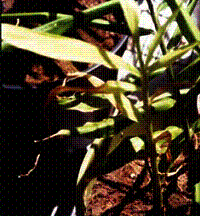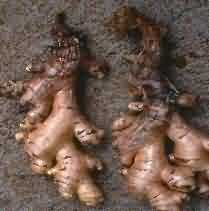अदरक की फसल केे प्रमुख रोग राईजोम रोट का प्रबंधन कैसे करें।
Ginger is one of the most promising spice crop grown in North Eastern States particularly in the state of Arunachal Pradesh, Meghalaya, Mizoram, Nagaland etc. It is estimated that 50% of the national production ginger comes from the North Eastern States. India one of the leading producer and exporter of ginger in the world. India’s production of ginger constitutes about 50% of the total world’s production of ginger. Rhizome or soft rot is one of the most devastating diseases of ginger causing heavy yield loss, wherever this crop is grown. Due to this disease more than 50% yield loss has been reported. This disease is mainly caused by the species of Pythium but associated with this disease are the fungus Fusarium spp. and the root knot nematode Meloidogyne sp. occasionally, the fungi Rhizoctonia solani, along with the bacterium Pseudomonas sp. have been isolated from diseased rhizomes.
Symptoms
- Initial symptom of the disease appear as light yellowing of the tips of lower leaves which gradually spreads down to the leaf blade and leaf sheath along the margin.
- In the early stages, the middle portion of the lamina remains green while the margins become yellow.
- The yellowing spreads to all the leaves of plant from bottom upwards and is followed by drooping, withering and drying.
- The collar region of the pseudo-stem shows pale translucent brown color which becomes water-soaked, due to destruction of parenchyma tissues.
- The infected shoot can be easily pulled out from the soil; the infection from the collar spreads to the rhizome gradually.
Causal organism: Fusarium oxysporium f.sp zingiberi, Pythium aphanidermatum, and Pythium myriotylum
Disease cycle and Environmental Relations:
- Infected rhizomes used for seed are the main agents of introducing the fungus in the field.
- Diseased plant debris containing oospores is the main source of soil-borne primary inoculums.
- Low-lying fields and water-logging are conducive to disease development.
Management practices:
Cultural management:
- Use of healthy planting materials is one of the most important measures for management of rhizome or soft rot of ginger.
- Water-logging in the field must be avoided.
- Provide proper drainage and keep land free from weeds at all times.
- Collect the diseased material as and when the disease is noticed and burn them.
- Early planting during April month.
Physical management:
- Treat the rhizomes with hot water at 51° C for 10 minutes.
Biological management:
- Spraying of the soil surface with Bordeaux mixture @ of 7 liter / square foot, once before sowing (6:6:50 conc. Means 6kg lime dissolve in 25 liter water and remaining 25 liter water dissolve 6kg copper sulphate therefore, mixed both solutions) and then after germination at 2-3 weeks interval (5:5:50 conc.) give partial control of the disease.
- Rhizomes treated with (Trichoderma bio-control agent) @ 5g / kg rhizome for 30 minutes
- Soil application of Trichoderma bio-control agent (2.5 kg mixed with 50 kg FYM) 10-15 days before sowing.
- Application of oil cakes made from Azadirachta indica, Calophyllum inophyllum, Pongamia glabra Hibiscus sabdariffa and Brassica compestris are recommended.
Chemical management:
- Dip rhizome in systemic fungicides viz. Ridomil MZ 72 @ 2g/liter of water or Topsin M @ 2g/liter of water or Apron 35 WS @ 2g/liter of water for 20 minutes and allow to air dry prior to planting.
Use of Resistant cultivar:
- Cultivars such as Maran, Nadiya and Narasapattom were found resistant to moderately resistant to P.aphanidermatum. The variety, Rio-de-Janeiro is highly susceptible.
Storage of planting material for effective management of rhizome rot of ginger
- Make a pit of 1 x 2 m2 size under shade.
- Spread a 5cm uniform layer of sand at the bottom of pit.
- Treat the ginger planting materials with Trichoderma bio-control agent @ 5g/liter of water for 30 min.
- Treated rhizomes keep under shade for 24 hours.
- Keep the dried rhizomes in pit and cover with fine sand layer.
- Next year used for planting purpose,


(a.) Above ground rot symptom (b.) Ginger affected by rot disease
Authors:
R.C. Shakywar, Krishna S. Tomar and M. Pathak
College of Horticulture and Forestry, CAU, Pasighat, Arunachal Pradesh
